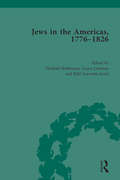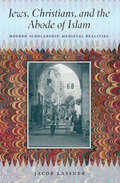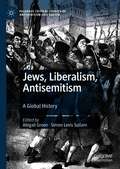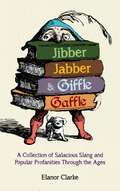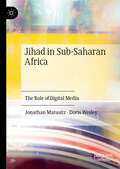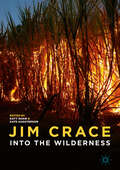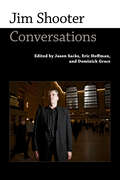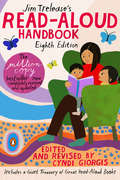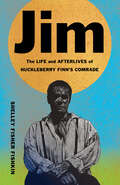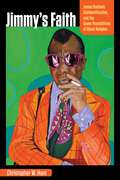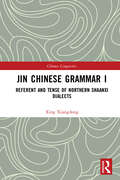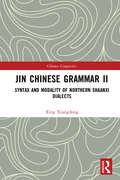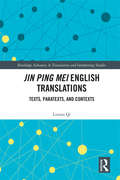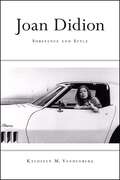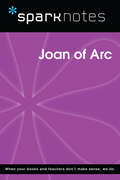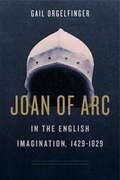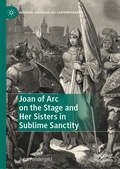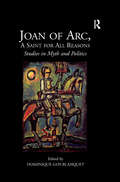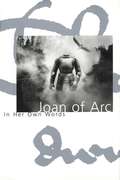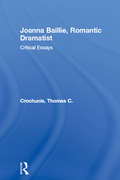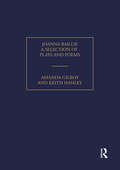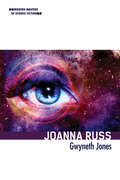- Table View
- List View
Jews in the Americas, 1776-1826 (Routledge Historical Resources)
by Michael Hoberman Laura Leibman Hilit Surowitz-IsraelThe period between 1776-1826 signalled a major change in how Jewish identity was understood both by Jews and non-Jews throughout the Americas. Jews in the Americas, 1776-1826 brings this world of change to life by uniting important out-of-print primary sources on early American Jewish life with rare archival materials that can currently be found only in special collections in Europe, England, the United States, and the Caribbean.
Jews, Christians, and the Abode of Islam: Modern Scholarship, Medieval Realities
by Jacob Lassner&“One of the greatest authorities on medieval Islam&” sheds &“immensely stimulating&” new light on cross-cultural relations in the Middle Ages (Times Literary Supplement, UK). In Jews, Christians, and the Abode of Islam, historian Jacob Lassner examines the relationship between the three Abrahamic faiths that defined their political and cultural interaction during the Middle Ages—and continues to define them today. Examining the debates taking place in modern Western scholarship on Islam, Lassner sheds new light on the social and political status of medieval Jews and Christians in various Islamic lands from the seventh to the thirteenth century. Using a vast array of primary sources, Lassner balances the rhetoric of literary and legal texts from the Middle Ages with other, newly discovered medieval sources that describe life as it was actually lived among the three faith communities. Lassner demonstrates what medieval Muslims meant when they spoke of tolerance, and how that abstract concept played out at different times and places in the Christian and Jewish communities under Islamic rule. Finally, he considers how this new understanding of medieval Islamic civilization might affect the highly contentious global environment of today.
Jews, Liberalism, Antisemitism: A Global History (Palgrave Critical Studies of Antisemitism and Racism)
by Abigail Green Simon Levis Sullam“This is a timely contribution to some of the most pressing debates facing scholars of Jewish Studies today. It forces us to re-think standard approaches to both antisemitism and liberalism. Its geographic scope offers a model for how scholars can “provincialize” Europe and engage in a transnational approach to Jewish history. The book crackles with intellectual energy; it is truly a pleasure to read.”- Jessica M. Marglin, University of Southern California, USAGreen and Levis Sullam have assembled a collection of original, and provocative essays that, in illuminating the historic relationship between Jews and liberalism, transform our understanding of liberalism itself. - Derek Penslar, Harvard University, USA“This book offers a strikingly new account of Liberalism’s relationship to Jews. Previous scholarship stressed that Liberalism had to overcome its abivalence in order to achieve a principled stand on granting Jews rights and equality. This volume asserts, through multiple examples, that Liberalism excluded many groups, including Jews, so that the exclusion of Jews was indeed integral to Liberalism and constitutive for it. This is an important volume, with a challenging argument for the present moment.”- David Sorkin, Yale University, USAThe emancipatory promise of liberalism – and its exclusionary qualities – shaped the fate of Jews in many parts of the world during the age of empire. Yet historians have mostly understood the relationship between Jews, liberalism and antisemitism as a European story, defined by the collapse of liberalism and the Holocaust. This volume challenges that perspective by taking a global approach. It takes account of recent historical work that explores issues of race, discrimination and hybrid identities in colonial and postcolonial settings, but which has done so without taking much account of Jews. Individual essays explore how liberalism, citizenship, nationality, gender, religion, race functioned differently in European Jewish heartlands, in the Mediterranean peripheries of Spain and the Ottoman empire, and in the North American Atlantic world.
Jibber Jabber and Giffle Gaffle: A Collection of Salacious Slang and Popular Profanities Through the Ages
by Elanor ClarkeSwear like a sparrow-mouthed snick fadger with the help of this illustrated dictionary of long-lost words and phrases. This crude and quirky volume contains the most amusing vocabulary from the murky Middle English of Chaucer right up to the more eloquent parlances of the early 1900s – essential for all lovers of weird and wonderful wordage!
Jibber Jabber and Giffle Gaffle: A Collection of Salacious Slang and Popular Profanities Through the Ages
by Elanor ClarkeSwear like a sparrow-mouthed snick fadger with the help of this illustrated dictionary of long-lost words and phrases. This crude and quirky volume contains the most amusing vocabulary from the murky Middle English of Chaucer right up to the more eloquent parlances of the early 1900s – essential for all lovers of weird and wonderful wordage!
Jihad in Sub-Saharan Africa: The Role of Digital Media
by Jonathan Matusitz Doris WesleyThis book examines how jihadist groups in sub-Saharan Africa have managed to advance their extremist agenda and recruit new followers thanks to digital media fueled by the information revolution since the dawn of the 21st century. This examination is based on a mixture of historical accounts, contemporary descriptions, case studies, theoretical applications, and an in-depth applied study (in the late chapters of the manuscript). An important conclusion is that the progress of jihadism in sub-Saharan Africa has been commensurate with the development and availability of digital media. This book breaks new ground in three ways. It is the first major academic work to devote most of its content exclusively to the use of digital media by jihadist groups in that region. Examples of jihadist digital media include social networking sites, online instructional videos, propaganda videos, and online jihadist magazines―among others. Secondly, it provides detailed case studies of both well-knownAfrican groups (e.g., Al-Shabaab, Boko Haram) and lesser-known ones― e.g., the Allied Democratic Forces in the Congo (which have, nevertheless, wreaked so much damage). Lastly, it is the first book to include an in-depth thematic analysis of online jihadist magazines―Inspire, Dabiq, Rumiyah, and Gaidi Mtaani―on their content dedicated to sub-Saharan Africa.
Jim Crace: Into the Wilderness
by Katy Shaw Kate AughtersonThis is a unique essay collection on Jim Crace, locating his writing within contemporary philosophical, cultural and political debates. This timely first critical collection of essays on Crace’s work provides a retrospective on his work to date, locating his work within a number of contemporary interdisciplinary critical and cultural perspectives and concerns, including post-humanism, post-millennial pastoralism, post-post feminism and gender, intersections between science and literary theory, environmental politics, the symbiotics of authorial and critical archival work, and the context of the burgeoning world of literary prizes. It includes additional contextual material in the form of an interview with Jim Crace and the re-publication of a seminal critical essay on “Craceland” by Adam Begley. As such this critical essay collection will be essential reading for anyone interested in contemporary fiction, and Crace’s unique writing.
Jim Shooter: Conversations (Conversations with Comic Artists Series)
by Jason Sacks, Eric Hoffman, and Dominick GraceAs an American comic book writer, editor, and businessman, Jim Shooter (b. 1951) remains among the most important figures in the history of the medium. Starting in 1966 at the age of fourteen, Shooter, as the young protégé of verbally abusive DC editor Mort Weisinger, helped introduce themes and character development more commonly associated with DC competitor Marvel Comics. Shooter created several characters for the Legion of Super-Heroes, introduced Superman’s villain the Parasite, and jointly devised the first race between the Flash and Superman. When he later ascended to editor-in-chief at Marvel Comics, the company, indeed the medium as a whole, was moribund. Yet by the time Shooter left the company a mere decade later, the industry had again achieved considerable commercial viability, with Marvel dominating the market. Shooter enjoyed many successes during his tenure, such as Chris Claremont and John Byrne’s run on the Uncanny X-Men, Byrne’s work on the Fantastic Four, Frank Miller’s Daredevil stories, Walt Simonson’s crafting of Norse mythology in Thor, and Roger Stern’s runs on Avengers and The Amazing Spider-Man, as well as his own successes writing Secret Wars and Secret Wars II. After a rift at Marvel, Shooter then helped lead Valiant Comics into one of the most iconic comic book companies of the 1990s, before moving to start-up companies Defiant and Broadway Comics. Included here is a 1969 interview that shows a restless teenager; the 1973 interview that returned Shooter to comics; a discussion from 1980 during his pinnacle at Marvel; and two conversations from his time at Valiant and Defiant Comics. At the close, an extensive, original interview encompasses Shooter’s full career.
Jim Trelease's Read-Aloud Handbook: Eighth Edition
by Jim Trelease Cyndi GiorgisThe classic million-copy bestselling handbook on reading aloud to children--revised and updated for a new generation of readers <P><P>Recommended by "Dear Abby" upon its first publication in 1982, millions of parents and educators have turned to Jim Trelease's beloved classic for more than three decades to help countless children become avid readers through awakening their imaginations and improving their language skills. Jim Trelease's Read-Aloud Handbook, updated and revised by education specialist Cyndi Giorgis, discusses the benefits, the rewards, and the importance of reading aloud to children of a new generation. Supported by delightful anecdotes as well as the latest research, an updated treasury of book recommendations curated with an eye for diversity, Jim Trelease's Read-Aloud Handbook offers proven techniques and strategies for helping children of all backgrounds and abilities discover the pleasures of reading and setting them on the road to becoming lifelong readers.
Jim and Jan
by Sara Palacios Cindy Peattie Elsa MannTitle contained within StartUp Phonic Core Program. Not Sold Separately
Jim: The Life and Afterlives of Huckleberry Finn's Comrade (Black Lives)
by Shelley Fisher FishkinThe origins and influence of Jim, Mark Twain&’s beloved yet polarizing literary figure Mark Twain&’s Jim, introduced in Adventures of Huckleberry Finn (1885), is a shrewd, self‑aware, and enormously admirable enslaved man, one of the first fully drawn Black fathers in American fiction. Haunted by the family he has left behind, Jim acts as father figure to Huck, the white boy who is his companion as they raft the Mississippi toward freedom. Jim is also a highly polarizing figure: he is viewed as an emblem both of Twain&’s alleged racism and of his opposition to racism; a diminished character inflected by minstrelsy and a powerful challenge to minstrel stereotypes; a reason for banning Huckleberry Finn and a reason for teaching it; an embarrassment and a source of pride for Black readers. Eminent Twain scholar Shelley Fisher Fishkin probes these controversies, exploring who Jim was, how Twain portrayed him, and how the world has responded to him. Fishkin also follows Jim&’s many afterlives: in film, from Hollywood to the Soviet Union; in translation around the world; and in American high school classrooms today. The result is Jim as we have never seen him before—a fresh and compelling portrait of one of the most memorable Black characters in American fiction.
Jimmy's Faith: James Baldwin, Disidentification, and the Queer Possibilities of Black Religion
by Christopher HuntQSpirit Top 24 LGBTQ Christian Books of 2024A novel approach to understanding the work of James Baldwin and its transformative potentialThe relationship of James Baldwin’s life and work to Black religion is in many ways complex and confounding. What is he doing through his literary deployment of religious language and symbols?Despite Baldwin’s disavowal of Christianity in his youth, he continued to engage the symbols and theology of Christianity in works such as The Amen Corner, Just Above My Head, and others. With Jimmy’s Faith, author Christopher W. Hunt shows how Baldwin’s usage of those religious symbols both shifted their meaning and served as a way for him to build his own religious and spiritual vision. Engaging José Esteban Muñoz’s theory of disidentification as a queer practice of imagination and survival, Hunt demonstrates the ways in which James Baldwin disidentifies with and queers Black Christian language and theology throughout his literary corpus. Baldwin’s vision is one in which queer sexuality signifies the depth of love’s transforming possibilities, the arts serve as the (religious) medium of knitting Black community together, an agnostic and affective mysticism undermines Christian theological discourse, “androgyny” troubles the gender binary, and the Black child signifies the hope for a world made new. In disidentifying with Christian symbols, Jimmy’s Faith reveals how Baldwin imagines both religion and the world “otherwise,” offering a model of how we might do the same for our own communities and ourselves.
Jin Chinese Grammar I: Referent and Tense of Northern Shaanxi Dialects (Chinese Linguistics)
by Xing XiangdongThis book is the first volume of a two-volume set that synchronically and diachronically studies the Jin dialect of Northern Shaanxi Province in China, with a focus on the grammatical features of pronouns, aspect and appearance, and the system of tenses. The Jin dialect of Northern Shaanxi is one of the most ancient, complicated, and representative dialects of the Yellow River region and figures prominently in our understanding of the Jin dialect and northern Chinese dialects as a whole. This volume first elucidates the semantic and dialectal differences in personal pronouns, demonstrative pronouns, and interrogative pronouns, as well as the special linguistic origins of the pronouns. The following chapter elaborates the different devices to express the status of realizing, accomplishing, lasting, and momentum-reducing as well as differences among similar aspectual markers and dialects. The final chapter examines the tense system, including anterior (past), posterior (future), and simple (present) tenses, the markers of which differ from each other in their syntactic representations.The book will be a useful reference for scholars and students interested in Jin dialects, Chinese dialects, and Chinese linguistics.
Jin Chinese Grammar II: Syntax and Modality of Northern Shaanxi Dialects (Chinese Linguistics)
by Xing XiangdongThis book is the second volume of a two-volume set that synchronically and diachronically studies the Jin dialect of Northern Shaanxi Province in China, with a focus on six grammatical features of the dialect.The Jin dialect of Northern Shaanxi is one of the most ancient, complicated, and representative dialects of the Yellow River region and figures prominently in our understanding of the Jin dialect and northern Chinese dialects as a whole. The book looks into the following six aspects of the dialect: subjunctive mood, expressions of complex sentence relationships, embedded sentence patterns, complex interrogative sentences, the formation of imperative modal particle “zhe”, and the phonetic variation of grammatical constituents. In the final chapter, the author discusses the significance of diachronic comparison as the research method for studying Chinese dialectal grammar.The book will be a useful reference for scholars and students interested in Jin dialects, Chinese dialects, and Chinese linguistics.
Jin Ping Mei English Translations: Texts, Paratexts and Contexts (Routledge Advances in Translation and Interpreting Studies)
by Lintao QiThis book investigates the English translations and adaptations of the sixteenth century classic Chinese novel Jin Ping Mei. Acclaimed the ‘No.1 Marvellous Book’ of the Ming dynasty, Jin Ping Mei was banned soon after its appearance, due to the inclusion of graphically explicit sexual descriptions. So far there have been more than a dozen English adaptations and translations of the novel. Working within the framework of descriptive translation studies, this book provides a translational history of the English versions of Jin Ping Mei, supported by various paratexts, including book covers, reviews, and archival materials. It also conducts textual comparisons to uncover the translation norms at work in the only two complete renditions, namely The Golden Lotus by Clement Egerton and The Plum in the Golden Vase by David Roy, respectively. The notions of agency, habitus and capital are introduced for the examination of the transference of linguistic, literary and cultural aspects of the two translations. The book represents the first systematic research effort on the English Translations of Jin Ping Mei. Given its pioneering status and interdisciplinary nature, the data, structure and findings of this book will potentially enrich the fields of Translation Studies, Comparative Literature, Chinese Studies, Cultural Studies and Book History.
Joan Didion: Substance and Style
by Kathleen M. Vandenberg2022 CHOICE Outstanding Academic TitleMuch acclaimed and often imitated, Joan Didion remains one of the leading American essayists and political journalists of the twentieth and twenty-first centuries. The lone woman writer among the New Journalists in the 1960s and '70s, Didion became a powerful critic of public and political mythologies in the '80s and '90s, and was an inspiration for those, particularly women, dealing with aging and grief and loss in the early 2000s. An iconic figure, Didion is still much admired by readers, critics, and essayists, who speak of looking to her prose style as a model for their own. In Joan Didion: Substance and Style, Kathleen M. Vandenberg explores how Didion's nonfiction prose style, often lauded for its beauty and poetry, also works rhetorically. Through close readings of selected nonfiction from the last forty years—biographically, culturally, and politically situated—Vandenberg reveals how Didion deliberately and powerfully employs style to emphasize her point of view and enchant her readers. While Didion continues to publish and the "Cult of Joan," as one author calls it, grows seemingly stronger by the day, this book is the only extended treatment of Didion's later nonfiction and the first sustained and close consideration of how her essays work at the level of the sentence.
Joan of Arc (SparkNotes Biography Guide)
by SparkNotesJoan of Arc (SparkNotes Biography Guide) Making the reading experience fun! SparkNotes Biography Guides examine the lives of historical luminaries, from Alexander the Great to Virginia Woolf. Each biography guide includes:An examination of the historical context in which the person lived A summary of the person&’s life and achievements A glossary of important terms, people, and events An in-depth look at the key epochs in the person&’s career Study questions and essay topics A review test Suggestions for further reading Whether you&’re a student of history or just a student cramming for a history exam, SparkNotes Biography guides are a reliable, thorough, and readable resource.
Joan of Arc in the English Imagination, 1429–1829
by Gail OrgelfingerIn this book, Gail Orgelfinger examines the ways in which English historians and illustrators depicted Joan of Arc over a period of four hundred years, from her capture in 1429 to the early nineteenth century.The variety of epithets attached to Joan of Arc—from “witch” and “Medean virago” to “missioned Maid” and “shepherd’s child”—attests to England’s complicated relationship with the saint. While portrayals of Joan in English popular culture evolved over the centuries, they do not follow a straightforward trajectory from vituperation to adulation. Focusing primarily on descriptions of Joan’s captivity, trial, and execution, this study shows how the exigencies of politics and the demands of genre shaped English retellings of her military successes, gender transgressions, and execution at the hands of her English enemies. Orgelfinger’s research illuminates how and why English writers and artists used the memory of Joan of Arc to grapple with issues such as England’s relationship with France, emerging protofeminism in the early modern era, and the sense of national guilt over her execution. A systematic analysis of Joan’s English historiography in its political and social contexts, this volume sheds light on four centuries of English thought on Joan of Arc. It will be welcomed by specialist and general readers alike, especially those interested in women’s studies.
Joan of Arc in the English Imagination, 1429–1829
by Gail OrgelfingerIn this book, Gail Orgelfinger examines the ways in which English historians and illustrators depicted Joan of Arc over a period of four hundred years, from her capture in 1429 to the early nineteenth century.The variety of epithets attached to Joan of Arc—from “witch” and “Medean virago” to “missioned Maid” and “shepherd’s child”—attests to England’s complicated relationship with the saint. While portrayals of Joan in English popular culture evolved over the centuries, they do not follow a straightforward trajectory from vituperation to adulation. Focusing primarily on descriptions of Joan’s captivity, trial, and execution, this study shows how the exigencies of politics and the demands of genre shaped English retellings of her military successes, gender transgressions, and execution at the hands of her English enemies. Orgelfinger’s research illuminates how and why English writers and artists used the memory of Joan of Arc to grapple with issues such as England’s relationship with France, emerging protofeminism in the early modern era, and the sense of national guilt over her execution. A systematic analysis of Joan’s English historiography in its political and social contexts, this volume sheds light on four centuries of English thought on Joan of Arc. It will be welcomed by specialist and general readers alike, especially those interested in women’s studies.
Joan of Arc on the Stage and Her Sisters in Sublime Sanctity (Bernard Shaw and His Contemporaries)
by John PendergastThis book examines the figure of Joan of Arc as depicted in stage works of the nineteenth and twentieth centuries, especially those based on or related to Schiller’s 1801 romantic tragedy, Die Jungfrau von Orleans (The Maid of Orleans). The author elucidates Schiller’s appropriation of themes from Euripides’s Iphigenia plays, chiefly the quality of “sublime sanctity,” which transforms Joan’s image from a victim of fate to a warrior-prophet who changes history through sheer force of will. Finding the best-known works of his time about her – Voltaire’s La pucelle d’Orléans and Shakespeare’s Henry VI, part I – utterly dissatisfying, Schiller set out to replace them. Die Jungfrau von Orleans was a smashing success and inspired various subsequent treatments, including Verdi’s opera Giovanna d’Arco and a translation by the father of Russian Romanticism, Vasily Zhukovsky, on which Tchaikovsky based his opera Orleanskaya deva (The Maid of Orleans). In turn, the book’s final chapter examines Shaw’s Saint Joan and finds that the Irish playwright’s vociferous complaints about Schiller’s “romantic flapdoodle” belie a surprising affinity for Schiller’s approach.
Joan of Arc, A Saint for All Reasons: Studies in Myth and Politics
by Dominique Goy-BlanquetThe interaction of poetry and politics has shaped Joan into a transnational myth dedicated to the most contradictory causes. No other character has inspired a more impressive list of writers, but no other myth possesses the malleability required to serve rival camps. Whatever their distortions of fact for art's sake, these famed authors deployed an extensive knowledge of known records. The quality of the exchanges between the best creative and philosophical minds of preceding centuries, their capacity for reading, range of interests, literary judgment, critical shrewdness, all offer priceless models of investigation for our times. A close inquiry into the makings of the legendary heroine brings to light various false impressions still endorsed today by a number of noteworthy historians and literary critics. This collection of essays, updated for the English language edition, follows Joan of Arc in the Western consciousness, throughout the chain of texts, fictions, comments, from the time of her launching into celebrity by Jean Gerson and Christine de Pizan to the most recent stage and film versions. D. Goy-Blanquet investigates the exchanges between England, France and Germany, down to Joan's nationalisation by Michelet. Francoise Michaud-Frejaville studies, through little known seventeenth-century versions, a period of decline in the heroine's popularity, with Jean Chapelain's much decried Pucelle at its lowest ebb. Nadia Margolis picks up the thread from Michelet to explore the background of frenzied political quarrels, and personal self-identifications, for possession of the nineteenth-century heroine, down to their ultimate appropriation, that by the National Front. Jacques Darras questions Peguy and the warmongers who used Joan as a firebrand against pacifists like Jean Jaures, down to the singular fate of Anouilh's L'Alouette, and beyond them the nationalistic strains which continue to infect the French political scene. An essay composed especially for this
Joan of Arc: In Her Own Words
by Joan Of Arc Willard TraskThe only available source for the exact words of Joan of Arc, compiled from the transcript of her trials and rearranged as an autobiography by Willard Trask.
Joanna Baillie, Romantic Dramatist: Critical Essays
by Thomas C. CrochunisThis superb collection of new essays offers a unique insight into the work of a leading women dramatist of the Romantic era. Contributors offer: *contextual material for those new to Baillie's work *examinations of the relationships between her plays and the philosophical and scientific writing of the era *discussion of Baillie's theatrical methods *extended interpretations of individual plays. Ending years of neglect of Baillie's crucial work, this volume is essential reading for those working on Romanticism, women's writing, or drama of the late eighteenth and early nineteenth centuries.
Joanna Baillie: A Selection of Poems and Plays (Pickering Women's Classics)
by Amanda GilroyThis work includes Joanna Baillie's important poems and critical prefaces, the tragedies "De Montfort" and "Basil", and the comedy, "The Alienated Manor", together with substantial extracts from her other works.
Joanna Russ (Modern Masters of Science Fiction #42)
by Gwyneth JonesExperimental, strange, and unabashedly feminist, Joanna Russ's groundbreaking science fiction grew out of a belief that the genre was ideal for expressing radical thought. Her essays and criticism, meanwhile, helped shape the field and still exercise a powerful influence in both SF and feminist literary studies.Award-winning author and critic Gwyneth Jones offers a new appraisal of Russ's work and ideas. After years working in male-dominated SF, Russ emerged in the late 1960s with Alyx, the uber-capable can-do heroine at the heart of Picnic on Paradise and other popular stories and books. Soon, Russ's fearless embrace of gender politics and life as an out lesbian made her a target for male outrage while feminist classics like The Female Man and The Two of Them took SF in innovative new directions. Jones also delves into Russ's longtime work as a critic of figures as diverse as Lovecraft and Cather, her foundational place in feminist fandom, important essays like "Amor Vincit Foeminam," and her career in academia.
